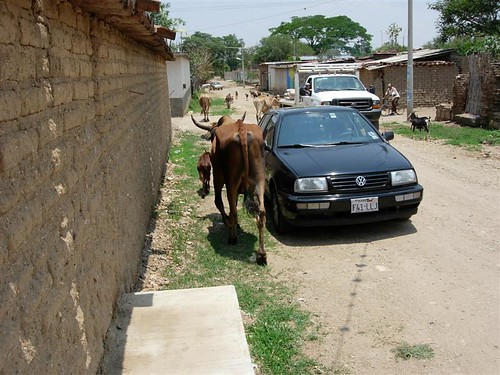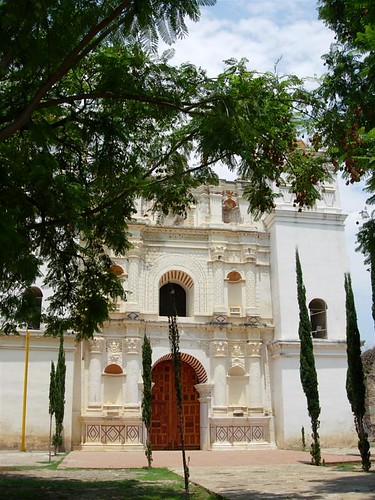La Profesora Abstraída
Weblog of Michelle Dion, Assistant Professor in the Department of Political Science, at McMaster University. My blog has moved to michelledion.com/blog. Visit my other website.Friday, August 05, 2005
The Mexican folk art market
Like most markets in Mexico, the government has had a hand in the folk art market for many years, providing subsidies to poor artisans who produce for national stores run by the government. The Social Development Ministry is revising the subsidy scheme, but how the changes will affect the income of artisans is not very clear.
You can view a catalogue online, but there are no online ordering or pricing information. I've been in these stores, and the art is nice, but more expensive than the pieces found in the private market. I wonder, now, how the salaries of government subsidized artisans compare to non-subsidized artisans.
The article also mentions that Chinese-made imitation artesania is being found in the private Mexican folk art market. Apparently, the Chinese have found a way to imitate Mexican designs and export their products to Mexico. Interesting, no?
Brian and I have several items of Mexican folk art, some of which we bought in Mexico City markets and others in regional markets. Only this last year, when we had a car in Mexico, were we able to go to the source. In Oaxaca, for instance, we visited one (San MartÃn Tilcajete) of the two towns that produces all of the painted wood animal art in Mexico.
These aren't the pieces we bought, but here's an example from the FONART site:

The amazing, but unsurprising, thing about this small town was that every family seemed to produce the little wooden figures. All the houses have signs on the outside inviting visitors to knock, and then you tour their little studios. We stopped at one of the first houses, and asked where we should visit next. The man of the house suggested we go to the back of town, along the dirt streets, and that there were more houses there. We visited one man who said that he made more money selling to the wholesalers, but that he liked to have visitors so he could see people's reactions to his creations. Unfortunately, he said, most visitors didn't make it to the back of town.
[Essentially, to visit without a car requires taking a bus from Oaxaca City and getting off at the entrance to the town. Then, you walk a kilometer to get to the town proper, and by then, most tourists don't want to wander around another square kilometer of town to visit all the houses. They stop at one or two stores along the main street and then hike back to the highway to catch a bus. When we visited, we made our way back out to the main street and stopped at one of the more "finished" shops. There we met a mother and daughter visiting from L.A. who asked for a ride back to the highway. We ended up offering them a ride all the way back to the City.]
Brian and I decided to buy one small piece from each family we visited in an effort to spread the wealth. Each family had a different style, too, which is not really apparent when you look at a store filled with all the figures in the D.F. One thing we noticed, however, was that the prices were higher and the quality poorer in the town. We attributed the prices to my unwillingness to bargain with someone over their art (it seemed unseemly) and the quality to the likelihood that the wholesalers buy all the "good" pieces.
In any event, so you get an idea of the types of towns that produce folk art in Oaxaca, take a look at these pictures.

That's our car, complete with Texas plates.

That's the town's Church.
The town had less than five paved streets, and the rest were dirt. The houses were made of cement block, usually unpainted.
posted by Michelle @ 11:15 AM,
0 Comments:

Go to main page:
La Profesora AbstraídaAbout me:
Name: Michelle DionLocation: Toronto, ON
View my complete profile
View my website

Previous Posts
- Global solidarity Sections of the national mining...
- Mexico now leader in kidnappings Mexico is now app...
- Politics or football?Politics. Football. At least...
- This brought back memories Those were the days. No...
- More drug violence in MexicoThis time not just alo...
- Avoid mugging, the remixAlex at Marginal Revolutio...
- All consumingFor a while, I have been looking for ...
- LaTeX woesI'm no computer dummy. Maybe I know just...
- Women in political science appear to be hitting a ...
- Consular offices in N.L. still closedAccording to ...

Archives
- 03/01/2004 - 04/01/2004
- 04/01/2004 - 05/01/2004
- 09/01/2004 - 10/01/2004
- 10/01/2004 - 11/01/2004
- 11/01/2004 - 12/01/2004
- 12/01/2004 - 01/01/2005
- 01/01/2005 - 02/01/2005
- 02/01/2005 - 03/01/2005
- 03/01/2005 - 04/01/2005
- 04/01/2005 - 05/01/2005
- 05/01/2005 - 06/01/2005
- 06/01/2005 - 07/01/2005
- 07/01/2005 - 08/01/2005
- 08/01/2005 - 09/01/2005
- 09/01/2005 - 10/01/2005
- 10/01/2005 - 11/01/2005
- 11/01/2005 - 12/01/2005
- 12/01/2005 - 01/01/2006
- 01/01/2006 - 02/01/2006
- 02/01/2006 - 03/01/2006
- 03/01/2006 - 04/01/2006
- 04/01/2006 - 05/01/2006
- 05/01/2006 - 06/01/2006
- 06/01/2006 - 07/01/2006
- 07/01/2006 - 08/01/2006
- 08/01/2006 - 09/01/2006
- 09/01/2006 - 10/01/2006
- 10/01/2006 - 11/01/2006
- 11/01/2006 - 12/01/2006
- 12/01/2006 - 01/01/2007
- 01/01/2007 - 02/01/2007
- 02/01/2007 - 03/01/2007
- 03/01/2007 - 04/01/2007
- 04/01/2007 - 05/01/2007
- 05/01/2007 - 06/01/2007
- 06/01/2007 - 07/01/2007
- 07/01/2007 - 08/01/2007
- 09/01/2007 - 10/01/2007
- 10/01/2007 - 11/01/2007
- 05/01/2008 - 06/01/2008
- 06/01/2008 - 07/01/2008
- 07/01/2008 - 08/01/2008
- 08/01/2008 - 09/01/2008
- 09/01/2008 - 10/01/2008
- 10/01/2008 - 11/01/2008
- 11/01/2008 - 12/01/2008
- 04/01/2010 - 05/01/2010